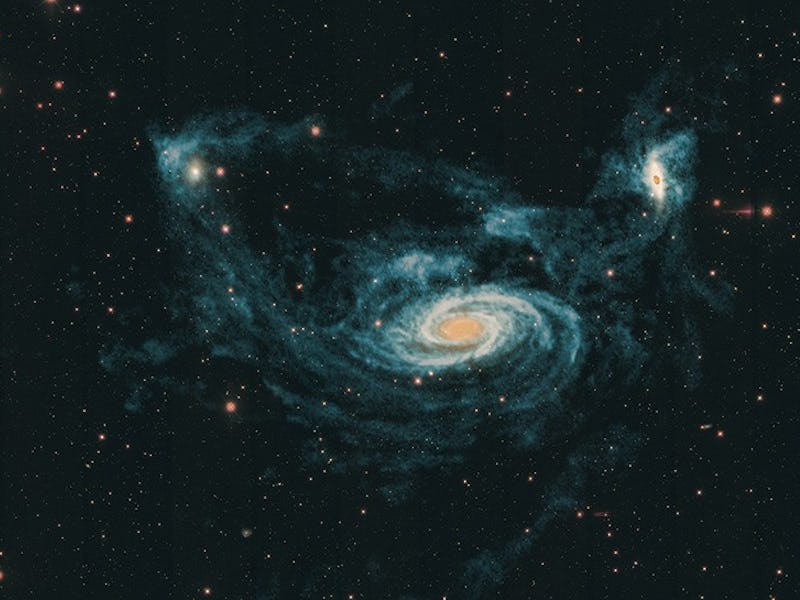Scientists measured a key ingredient in star formation for the first time
This study fills a major gap in scientists' knowledge about how the universe' first galaxies formed.

During the early universe, galaxy and star formation was at an all-time high.
A mere few hundred million years after the Big Bang, nearly half of the stars that have ever existed had already formed.
The rate of star formation has decreased by tenfold since then, but there is a missing piece in the story of what fueled the rapid spurt of star births early in the universe, and why the growth has since slowed.
The mystery centers on atomic hydrogen — a key ingredient in star formation and the fuel for this early burst of productivity.
To try and solve this, a team of scientists measured atomic hydrogen in more than 7,000 galaxies during a period of the universe in which galactic formation was at its peak. Their findings are detailed in a study published Wednesday in the journal Nature. The data reveal new clues into the earliest years of the cosmos and how it continues to evolve today.
During the early universe, atomic hydrogen made up the majority of gas in younger galaxies.
Stars form as interstellar gas falls into galaxies, creating hydrogen atoms which are then converted to molecular hydrogen. This directly fuels the birth of stars.
Hydrogen atoms have been detected in nearby galaxies, but the atomic gas is harder to detect in galaxies that are farther away. As a result, the exact details of the gas that fueled early star formation remained an enigma.
To observe the process in these distant galaxies, the scientists behind the new study used the Giant Metrewave Radio Telescope, located near Pune, India to measure the emissions of neutral atomic hydrogen in a total of 7,653 galaxies.
The telescope was used to peer back into the early universe and measure the gas that birthed young stars.
The galaxies were all over 0.4 redshift, which is a unit of measurement denoting an object's distance from Earth. Redshift depends on how light shifts toward shorter or longer wavelengths as objects in space move closer or farther away from us. The farther away an object is, the more the light is shifted towards the red end of the spectrum.
The galaxies studied here are located in the early universe, in a region of space and time when galaxy formation was at its peak — around four to seven billion years after the Big Bang.
Galaxies at that time contained about 2.5 times more of this gas relative to their stellar masses than galaxies do today. The huge amount of this gas in these early galaxies could explain the higher rate of star formation during that time of cosmic history, the results suggest.
Atomic hydrogen was consumed relatively quickly in the process of star formation, the study suggests. That means the accretion of the gas would have had to have been somewhat continuous in order to keep up with the rate of birth of these young stars, the study finds.
In that sense, it is perhaps no surprise that star formation slowed down, given that the production of hydrogen gas did not remain high enough to meet the high output of baby stars.
The study does not conclude whether the gas was mostly found in larger galaxies, or if it was distributed among all galaxies equally, however. So there are still some missing details scientists will need to fill in with future observations of the distant universe.
The scientists behind this study hope to use the upcoming Square Kilometre Array, a radio telescope designed specifically to detect hydrogen emissions from distant galaxies, to try and answer these fundamental questions of how our universe formed.
Abstract: Baryonic processes in galaxy evolution include the infall of gas onto galaxies to form neutral atomic hydrogen, which is then converted to the molecular state (H2), and, finally, the conversion of H2 to stars. Understanding galaxy evolution thus requires an understanding of the evolution of stars and of neutral atomic and molecular hydrogen. For the stars, the cosmic star-formation rate density is known to peak at redshifts from 1 to 3, and to decline by an order of magnitude over approximately the subsequent 10 billion years1; the causes of this decline are not known. For the gas, the weakness of the hyperfine transition of H I at 21-centimetre wavelength—the main tracer of the H I content of galaxies—means that it has not hitherto been possible to measure the atomic gas mass of galaxies at redshifts higher than about 0.4; this is a critical gap in our understanding of galaxy evolution. Here we report a measurement of the average H I mass of star-forming galaxies at a redshift of about one, obtained by stacking2 their individual H I 21-centimetre emission signals. We obtain an average H I mass similar to the average stellar mass of the sample. We also estimate the average star-formation rate of the same galaxies from the 1.4-gigahertz radio continuum, and find that the H I mass can fuel the observed star-formation rates for only 1 to 2 billion years in the absence of fresh gas infall. This suggests that gas accretion onto galaxies at redshifts of less than one may have been insufficient to sustain high star-formation rates in star-forming galaxies. This is likely to be the cause of the decline in the cosmic star-formation rate density at redshifts below one.